Latest questions and
answers More Q&A Gunwriters Link page

Custom Search
Q&A since 03.09.1999
G.O.W. Kickback:
Questions and Answers
Answered by: P. T. Kekkonen
"Norsupyssy" L-39
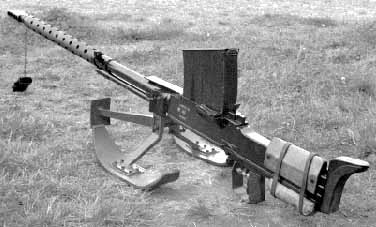 Pete. Thank you very
much. I will spread your information around the class 3 world. (Thats what we call the
machine gun and cannon nuts) My gun is number 784. It is a handfull to shoot, it knocks me
back about 6 inches when I'm lying behind it. The fellow I bought it from got his first
one when he was 12 years old. He used to tow it in a wagon behind his bicycle. He fired
some 6,000 rounds through it back when ammo was cheap. Now it costs about $40 per round.
We tend to weld one of the gas ports shut so we can use it as a single shot and avoid the
brass being damaged when it is ejected. That's probably why it kicks so much.
Pete. Thank you very
much. I will spread your information around the class 3 world. (Thats what we call the
machine gun and cannon nuts) My gun is number 784. It is a handfull to shoot, it knocks me
back about 6 inches when I'm lying behind it. The fellow I bought it from got his first
one when he was 12 years old. He used to tow it in a wagon behind his bicycle. He fired
some 6,000 rounds through it back when ammo was cheap. Now it costs about $40 per round.
We tend to weld one of the gas ports shut so we can use it as a single shot and avoid the
brass being damaged when it is ejected. That's probably why it kicks so much.
I have a Russian friend I buy night vision gear from. I told him about the Lahti and I
teased him that it has pictures of 6 russian tanks and 5 trucks painted on the side. He
wasn't impressed. My latest project is a 20mm Hispano Machine gun. I'm looking for a 60
round drum mag for one. With your permission, I would like to post your letter on some of
the MG boards. It has some great historical info.
Thanks, John
Comments: When
AIMO J. LAHTI designed L-39, some authorities of the martial
medicine warned that "this horrible shoulder-fired artillery piece shall kill it's
shooter by the recoil with it's very first shot". It was, of course, the Grey Theory.
The autoloading action of L-39 removed ca. 25 % from the felt recoil of that rifle and the
muzzle brake eliminated 44 % from the remaining recoil. Brother of the designer, Aarno
Lahti, test-shot the very first prototype rifle. He shot two magazines full of
anti-aircraft cannon cartridges without a sign of approaching death, asking for some more
cartridges, but they were no more available for that first shooting session.
It is still one more trick for reduction of "Elephant Gun's" felt recoil: Do not
squeeze the "horror handle" of a pistol grip while you pull the trigger. Let the
action to stay open until the rifle is returned to it's position after the shot. After ca.
one second, let the action to go forwards, without yet pulling the trigger. The felt
recoil shall become divided in two rather mild separate pushes.
If the gas port is welded-up, this trick cannot work, and you must suffer from 25 % more
recoil than the shooter of autoloading L-39. It hurts, but is not yet able to kill.
Removing of the muzzle brake may lead to more severe consequences, but the recoil of
sawed-off L-39 is again tolerable. Noise of the report is horrible, of course, but
considerable reduction of the muzzle velocity is able to reduce the recoil, accordingly.
Of course you can use the information of my letter. Permission granted! There is one place
in it, written too much hurrying: In the early 1960s were Finns ENDING (not STARTING)
trials with full-auto anti-aircraft versions of L-39. Those trials were ended
"officially" as early as in 1953, but continued furtively. Rifles were declared
obsolete not until the late 1980s in Finland. Selective fire trigger mechanism might be
designed along with the rifle itself, but adopted not until needed.
01091999; Pete
7.62 mm Mosin's reduced loads
Thanks Pete. I have a case of Russian ammo, stamped "188" and "83" on
the bottom of the case. I believe, that is factory nr. (?) and year of manufacture. It is
the pointed, hollow base bullet, 147 grains in weight. I have decided to just use the
Russian ammo as it is (no fooling around), and buy 100 rounds of Sellier & Bellot to
fire and use for reloading following the directions in a reloading manual. Better safe
than sorry !
I will probably try some of your "cat's sneeze" loads. Very much enjoy the
Finnish history you write about. Take care !
Regards, Patrick
Comments: Jess, the stamp "188" at twelve-o'clock position on the case head is a
factory-code number and "83" six-o'clock denotes the year of loading. That
bullet is a common "Lyohkaya Pulya" of year's 1908 pattern (or model 1908/-10,
when equipped with a crimp-groove). It means "the light bullet". Because you
have just one case (box ?) of these cartridges, it is advisable to shoot them as they are.
These "L 1908" bullets were seated into some reduced charge cartridges in
Soviet-Russia as follows:
1) ½-charge loads with ca. 10 grains of revolver powder. Muzzle velocity ca. 1480 fps.
Blackened brass case. Headstamp may be British or American, of World War I era (1916 or
17). Cartridges were used in the rifles with the earliest S-40 silencers, but they were
loaded presumably in 1939 and 1940. Finnish copy of them was VPT A0230, loaded in 1942.
Blue case-neck and bottom. Ballistics like those of a Russian cartridge: Too high muzzle
velocity.! The suppressor was useless.
2) Partizan cartridges pre-1941 with 0.50 gram of Sokol powder (or it's predecessor), id
est 7.7 grains. Nominal muzzle velocity 860 fps. Subsonic; better for suppressed rifles
than supersonic "black cartridge". Brass or copper-plated steel case with green
code color: 1/3 of case length and the bullet were lacquered green, but sometimes entire
length of the case was lacquered green and the bullet was not color-coded at all. These
cartridges were and they are extremely rare items, met in museums only. Russian swindlers
are trying to sell the common T-30 tracer cartridges as "partizanniy patronniy"
to the western collectors, but it is easy to identify the tracer cartridge: It's powder
charge fills the case. It does not tinkle in the cartridge. Charge of the partizan
cartridge fills about one third of powder space. Faked "partizan cartridges" may
be, however, reloaded with the reduced charge afterwards.
3) Partizan cartridges post-1941. Similar to pre-41 loads but with color code: Green
bullet tip (of a length just .2 inch) and primer annulus. These factory-loadad cartridges
were presumably never actually issued to the partizans. Not loaded in quantity. Ultra-rare
items ! Never seen today outside the museums. Once again: Beware of the fakes &
"fakirs" ! (This is an additional knowledge to "ARCANE"
series. Source of information: Philippe Regenstreif; France. Black cartridges are,
however, met in Finland only !).
"Repetitio est mater studiorum":
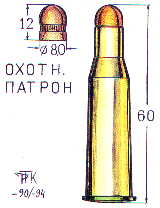
Non-Finnish web-visitors tends to use the term "Cat's
Sneeze" for any & all reduced charge loads. It is needed to define the
nomenclature still once again: "Cat's sneeze" is loaded with a bore-sized or
slightly smaller spherical lead bullet (usually a buckshot), propelled with a primer only
or with a booster charge of quickly burning powder. The bullet is centred in the case
mouth with some kind of lubricant. In Finland is the bovine shortening (neat's fat) the
most popular low-velocity bullet lube. Why pay dear, when you can get the functioning
stuff at 1/50 price per weight ?
Gallery Load is loaded with a spherical lead bullet and a booster charge of
"rapid" powder. Bullet diameter is groove-sized or still bigger. Cast or
factory-made bullet for .31 caliber percussion revolver is good for 7.62 mm Mosin rifle
and most of .30 (.308) caliber rifles too... (Experience since 1980). The Spanish
buckshots, available in Finland, have variable diameter, according to our new gunwriter
Markus (age just 15 years, but his scrupulousness is much better than the
conscientiousness of some dilettante engineer-graduate contributors to printed magazines,
at the age of 60 + years.!).
Markus has sorted out the buckshots, with nominal diameter 7.65 mm, to two main size
groups: Those for "cat's sneezes" and the bigger balls for the "gallery
cartridges". He has designed a very clever gallery cartridge loading method for .308
Winc. ammo with the buckshots of actual diameter .305" to .307", by the use of
1/4 strip of double thickness toilet tissue as an over-powder wad rammed tightly on the
3.9 grains charge of N 310 and another 1/4 strip as a fluffy wadding just behind the case
neck. Cases are resized without neck expanding. Bullets are flush-seated and some melted
neat's fat (a bovine shortening) is dropped on them. Accuracy of these loads is much
better than that of a .22 LR rifle, loaded with some cheap bargain-sale cartridges; five
shots groups in less than an inch to 25 meters, and the report noise is very low;
"silent without a suppressor or silencer". All of those buckshots used are too
small for the real Gallery Loads, but those two waddings, slamming together and then on
the soft lead bullet, shall expand the spherical lead bullet to become groove-sized.
For the 7.62 mm Mosin Gallery Cartridge is a .31 caliber percussion revolver bullet
excellent, loaded with four grains charge of rapid powder (VihtaVuori N 310 or Hodgdon
Universal) and a ½ strip of toilet tissue wadding rammed over the powder; the bullet
seated flush with the mouth of an un-resized case, previously shot in your rifle and some
kind of lubricant dropped on the bullet.
Other type of 7.62 mm reduced charge loads is the Hunting Load (for small game) with a
short bullet, weight no more than five grams/ 77 grains. A bullet of .32 A.C.P. is
suitable, but the load must be supersonic, because there are jacketed bullets with a
diameter .315" no more/ not yet available. Minimum powder charge with a jacketed
bullet is 1/10 bullet weight of N 310 or Universal powder. Usual charge with Lapua .32 ACP 75 gr. FMJ-RN bullet was a 9 mm Luger case
full of powder N 310, or 8.5 grains; somewhat cracky load, but a skilled marksman could
take a bull-moose with it. Production of these bullets is recently discontinued, of
course... (It was among the most horrible DumDums when the striking velocity was 2600 fps
+ ).
A nice Partizan Cartridge you may load with 110 grains Sierra FMJ-RN (M1 Carbine standard bullet) and
the same 8.5 grains of N 310 powder. This combination is usually subsonic in original
Mosin-Nagant M/1891 rifles, but the charge may be reduced to 6.2 grains if necessary.
Further reduction is unadvisable!
There are not reloading manuals for the reduced charge loads available at all. Don't waste
your time for finding one. This kind of data is available from our "G.O.W." web
sites only! Hodgdon Powder Co. Inc. may try to break
our monopoly, but they are almost 20 years behindhand with my work. Finnish Vihtavuori has given up fifteen
years ago.
01091999; Pete
 Question
about Lahti 39
Question
about Lahti 39
Hi I enjoyed looking at the pictures in your Lahti article. I have an L-39 Lahti 20mm
rifle and I enjoy it a lot. I was wondering if you have ever written the same article in
English? By the way, I see in the picture, an unusual aircraft sight on the rifle. Is this
your rifle? Did you mount the sight yourself or was that a standard variation for it? Is
that pedestal mount standard?
Thanks, John - just another MG junkie...
That
Lahti article on the Finnish questions & answers column was
not an article but a collection of old surplus drawings (see dates of the signatures) with
somewhat expanded captions. The whole story re special cartridges of Lahti anti-tank rifle
was published in an abortive Finnish magazine "Asemaailma" ("Weaponry
World"). I found that odds & ends material by a lucky accident from my home
archives. Now I am seeking that issue of Asemaailma, containing that story and other
drawings & photographs with an intention to translate it into English - if I shall get
some time for this project. This a-t rifle on the photographs is property of a Finnish gun
collector. It is de-activated. All the equipments are of original issue and standard.
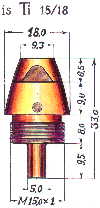
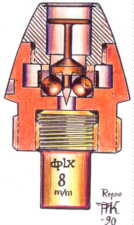
These rifles were used during 1941-44 Russo-Finnish war for sniping and counter-sniping.
The accurate and effective range was twice as long as that of 7.62 mm sniping rifle,
despite of fact that Russian snipers could shoot at ca. 900 yards. Finnish countersnipers
shot with high-explosive (T.N.T.-filled) shells to almost 2000 yards ranges... It was also
amusing to set the forest on fire with the red incendiary shells to range 7000 yds +
behind Russian lines. (That war was immobile trench warfare since the end of year 1941
until the June 1944). Sight was not needed, but just an improvized quadrant for the barrel
elevation +32 degrees of angle to get the maximum range. Sensitive point-impact fuzes
exploded those phosphorus-filled shells on the tree branches or twigs. The tree-top fire
was very difficult to control and extinguish...
All the fuzes were made in Finland but those Duplex boosters were swapped with Suomi
submachine guns from Germany. Duplex booster was needed to shatter the phosphorus-filled
shell and splash the burning phosphorus all over. Those improved fuzes were
ultra-sensitive. Use of them was prohibited in rainy days, because the raindrops could
cause prematures... Otherwise was the TIKKA Ti 15/18 fuze safe to use, handle and
transport but still among the most reliably functioning fuzes for the 20 mm shells during
II World War: The best one.
That blue projectile was a solid shot of hardened steel, able to penetrate obsolescent
Russian tank's or armored car's side or back armor plates. Even the heavy main
battle-tanks T-34 and Klim Voroshilov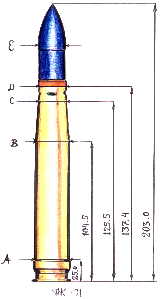 were possible to immobilize with ten shots on the track link, or the turret
was "riveted" with these blue bullets aimed into the seam between tank hull and
turret. Some extra "rivets" could prevent elevation of the turret cannon.When
the Russian tank crew tried to traverse that riveted turret, some brave Finnish warrior
slipped ten or twelve pounds charge of T.N.T. below the tank's belly and pulled the string
of 5½ seconds time fuze. The dose was sufficient to kill the crew, but the tank was many
times repaired for use of Finns.
were possible to immobilize with ten shots on the track link, or the turret
was "riveted" with these blue bullets aimed into the seam between tank hull and
turret. Some extra "rivets" could prevent elevation of the turret cannon.When
the Russian tank crew tried to traverse that riveted turret, some brave Finnish warrior
slipped ten or twelve pounds charge of T.N.T. below the tank's belly and pulled the string
of 5½ seconds time fuze. The dose was sufficient to kill the crew, but the tank was many
times repaired for use of Finns.
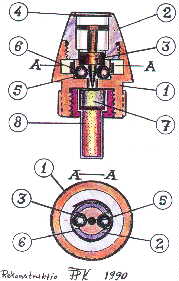
Russian IL-2 land-strafing aeroplanes were heavily armored "flying tanks",
impossible to destruct with usual infantry firearms and too swift to get down with
anti-aircraft artillery. An anti-tank rifle, mounted with a "Christmas tree
fastening" on the tree stump 5½ feet high was flexible enough for dropping of these
"Stormovik" planes.
It was usual trick to remove the sear of L-39 and use the handle of action hold-open lever
as a trigger. The rifle shot full-auto fire, when the sear was removed, with a cyclic rate
ca. 400 rounds per minute. If the incendiary shells with a tracer were available, they
were loaded into the magazine alternately with blue AP bullets, but the penetrating
bullets only could also destruct the Flying Tank.
Pilots of these planes were foolhardy kids from Comsomol; not the experienced fighter
pilots needed for the dogfights against Germans in the cockpits of "Shylock's
presents", Airacobra and Mustang fighter planes - donated by U.S. Government to
Stalin. Excessive trust in armor plating of Stormovik planes was fatal to many pilots.
Sometimes was the shooting range about similar to that of duck-hunting with a shotgun.
Many times the pilot was killed in action with a direct hit through the cockpit.
Evolution of the Norsupyssy ("Elephant Gun" in Finnish) was continued still
after the WW II, presumably until early sixties, because a tree-mounted 20 x 138 mm gun,
able to shoot burst fire, was considered to be an ideal weapon against helicopters. Last
guns produced were equipped with a fire selector. Full-auto shooting was, however, too
stressing. Receivers of these anti-helicopter guns disintegrated, when the riveted
construction failed, and there was not enough grants made for re-design of receiver to
become burst-fire proof.
These three Finnish rounds of ammo were designed especially for L-39 rifles. (A fact
unknown abroad and less-known in Finland too). All kinds of 20 x 138 mm Solothurn Long
cartridges were possible to shoot from "Elephant Gun", but with somewhat less
accuracy. German, Italian and Swiss ammo were imported plentily during 1941 - 44 war.
The pedestal is made for display purposes but the mount is an original item of L-39. There
was a big wooden case full of more or less necessary outfit along with each rifle sold by
the Army sales. Unfortunately all the firearms, caliber 20 mm or more, were sold only in
de-activated condition, but I have shot safely a couple of shells from a
"regenerated" Russian 82 mm trench mortar. De-activation is not an irrevocable
action...
18081999; PeTe
Silencer and Suppressor
Those devices seems to be similar. What makes the firearms to become "silent"
like in the movies or TV spy and crime series ? Why the "suppressors" despite of
more diameter and length of them are less efficient devices ?
"Maxwell Smart Jr."
Silencer
and suppressor are alternative names of the very same device. Third name is a "sound
moderator", coined by a British manufacture Parker-Hale for goofing of U.S. customs
officials after the validation of Lex Morgenthau in 1934.
"Moderators" for .22 rimfire arms were declared as the "parts of wireless
receivers" as late as in the early 1970s, until an author of the book "SURVIVAL
POACHING", known by a pseudonym "Ragnar Benson", exposed that trick.
Silencer is a somewhat misleading name, coined by HIRAM PERCY MAXIM
in 1908. It is impossible to design truly silent weapon, throwing some kind of efficient
projectiles. There is a sound "PHOOD" audible even when one is using a blowpipe
and a twang of the string when the bow and arrow are used. Snap of the crossbow string may
be more noisy than is the mild report of a 7.62 mm Russian military rifle, shot with a
Finnish low pressure cartridge m/-36 or Russian Ohotnichye Patron.
A gunshot may, however, become (almost) silenced or just suppressed. The same device may
be a "silencer" or a suppressor, if it is long and fat enough - and designed to
stand the muzzle blast of full-power loads. It is possible to suppress the signatures of
shooting - the muzzle blast and flash along with the recoil - efficiently by the use of a
well-designed device, but it is impossible to suppress the blast of an usual revolver
(leaking the powder gas through the gap between it's barrel and cylinder) or the
mechanical noise of any selfloading or full-automatic firearms, and that "whiplash
noise" of a bullet flying silently through the roaring air, just like a jet aircraft
at the supersonic velocity.
The flight noise of a bullet is easier to evade than death or taxes - by use of the
cartridges with a subsonic bullet speed. These special rounds are available also for some
rifles, but the handloading is the most usual way to get them. Some handgun cartridges,
like .45 A.C.P. (with usual bullet weight) are inherently subsonics. If the velocity
reading is written or printed with three digits (up to 999 feet per second), the bullet
velocity is subsonic in all those atmospheric conditions comfortable enough for outdoor
activities.
The former suppressor shall become a "silencer" when the bullet velocity is
reduced to the subsonic level. Some shooting signatures are impossible to avoid: The
"gap blast" of the revolver (save the rare curios like Russian Nagant R 1895 and
some other still more rare gas-sealed wheelguns like Belgian Pieper), or the mechanical
noise of autoloading actions. Even the hit on the target shall cause the noise, if all the
other shooting signatures are eliminated by some means - an impossible mission as it is.
I don't know, how the sound-track recording engineers of Hollywood or TV studios are made
that synthetic "TSYOUP, TSYOUP" sound of the silenced firearms (including
revolvers !) but I think, they have never listened the actual reports of silenced or
suppressed firearms - and the thuds of the bullets, hitting on the living tissue; flesh
and bone.
For those Americans going to handloading of the subsonic rifle cartridges may be
interesting the website addresses of my good friend MIKE DALY of HODGDON POWDER Co. Inc: <hpchelp@swbell.net> or <help@hodgdon.com>. Telephone 913-362-9455, FAX
913-362-1307, postal address 6231 Robinson Shawnee Mission, KS 66202. Australian
manufacturer of Hodgdon "Universal" powder has also confirmed these good news
that a world-wide distributor of it handles all of the reloading enquiries.
25081999; PeTe
Reduced loads for 7.62 x 54 R
Enjoyed reading your answers. Maybe you can help me ? I have a Finnish Mosin (M39) and
would like to load some reduced loads (but not subsonics), with ballistics similar to
30-30 or 7.62 x 39.
1) I have some surplus Russian 7.62 x 54R with 48.3 grains of extruded powder, 147 grain
FMJ bullet, and was thinking to pull the bullets, and load some starting at 41 grains,
then 42, then 43, and finally a couple rounds at 44 grains. Would charges such as this be
dangerous for detonation / S.E.E. ?
2) I have some Hodgdon H-380. Would this be better, and how much of a charge would give
muzzle velocity of approximately 2300 feet per second (about 700 meters per second).
Thank you for your time
Patrick
1)
Rule number one: "Never use unknown powder for reloads !".
Rule number two: "Never use the rifle powder for reduced charge rifle loads - unless
it is one of the most rapidly burning propellant already classified as rifle powder;
practicable for the Magnum revolver cartridges too!".
Extruded Russian powder may or may not be somewhat flexible, but are your cartridges
loaded during Imperial Russian, Soviet Russian or Free Russian era ? (Pre-1918 ? Post 1930
to 1945 ? Post-1945 era ?) Headstamp of case tells the vintage. Is the bullet pointed flat
(hollow) based "Lyohkaya Pulya of year's 1908 pattern ?" or a boat-tailed
post-WW II "Lyohkaya Pulya s Serdche ?" (= light bullet with iron core; since
1983 with a hardened steel core, color coded with silver-looking tip painted with
aluminium lacquer). There are too many unknown properties of cartridges and bullets for
developement of a reduced charge even with a fresh and known powders.
Suitable propellants are: Vihtavuori
N 110, IMR or Hodgdon 4227 and SR 4759 (last
mentioned is especially made for reduced charges, somewhat more powerful than subsonic
ones. It was once declared as "obsolete propellant" but returned to the
production because of demand). Without knowledge on the age and condition of the cases and
the bullet design it is too risky to quess the powder charges for the handloads. Charge
less than 45 grains may develope S.E.E. if the primer is faulty.
2) H 380 shall give the 2600 fps muzzle velocity with the listed minimum charge 50 grains.
Suggested charge is ca. 53 grains, giving about 2700 fps velocity. It is, however,
advisable to shoot these surplus cartridges with their original charges, if the powder is
undeteriorated (not stinking acrid, clumped or looking "rusty"). Most Russian
rifle powders are almost everlasting, if they are not moistened or made during the
"hard times" (with headstamps 41 to 45 at "six o'clock" position on
the case heads), but the primers may be inert or give hang-fires.
Russian pointed L-bullets are unable to give a good or even fair accuracy in any rifles
because they are too thin (with .307" / 7.80 mm diameter) even for the .308 caliber
bores. Finnish "Ukko-Pekka"
M-39 rifle has chamber and bore dimensions about similar to the original MOSIN-NAGANT
M/1891. Russian LPS boat tail bullets gave also just a fair accuracy, but since 1983 they
became greatly improved by adoptment of a lathe-turned steel core instead of chopped and
swaged iron core. Sorry, I am unable to give more exact loading data, because of
insufficient (= non-existent) information re your cartridges.
Night of St. Bartholomew 1999; PeTe
Details of Russian Glushityel
What are those numbered parts of exploded drawing of the Glushityelj suppressor described
in Arcane 3 story of Gunwriters and in one of your Kicback
answers below? What do the Russian letters mean?
The
legend is as follows:
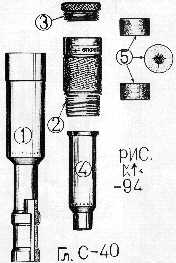 1: Suppressor jacket with integral bayonet mounting
sleeve. This rough drawing is lacking a "tablicha" = table of the sight
adjustment and a warning: "Use with black (or green ?) cartridges only. Do not shoot
fighting ammunition", engraved or stamped on the jacket.
1: Suppressor jacket with integral bayonet mounting
sleeve. This rough drawing is lacking a "tablicha" = table of the sight
adjustment and a warning: "Use with black (or green ?) cartridges only. Do not shoot
fighting ammunition", engraved or stamped on the jacket.
2: Intermediate chamber with left-hand threads (male and female). Text: "OTKROY"
= "twist open".
3: End cap.
4: Distance piece. The rebated "neck" was pressed on the rifle muzzle when the
flange compressed the rearmost rubber wipe.
5: Rubber wipes or "shoot-through baffles". There were two of them in S-40
suppressor and three wipes in a rare S-43 variation along with an extra intermediate
chamber. This third wipe destructed usually the shooting accuracy, and in 1943 even those
S-40 suppressors were found to be meaningless devices. 7.62 mm Partizan cartridges were as
"silent" or noisy with or without the "glushityel". Thickness
of these wipes was originally 25 millimeters but it was later reduced to 15 mm. The
rearmost wipe was also a mounting spring of the suppressor.
Lower text is a Russian abbreviation: "Gl. S-40", presumably derivation
from words: "Glushityel Sestoryechskogo-Sorok" = "suppressor of
Systerback (arms manufacture) - model Fourty". Upper legend is: "Ris." (=
"risunok" = "drawn by") and "PT -94" as the
signature. Text: "PT" is not of Russian but old Scandinavian rune letters. Nota
bene: Rune alphabets on the WEBSTER's Dictionary are of German/Gothic type. There were at
least eight more or less different elements of rune.
19th Aug. 1999; PeTe
More >>